open hood VOLVO V60 2016 Owner´s Manual
[x] Cancel search | Manufacturer: VOLVO, Model Year: 2016, Model line: V60, Model: VOLVO V60 2016Pages: 402, PDF Size: 10.3 MB
Page 10 of 402
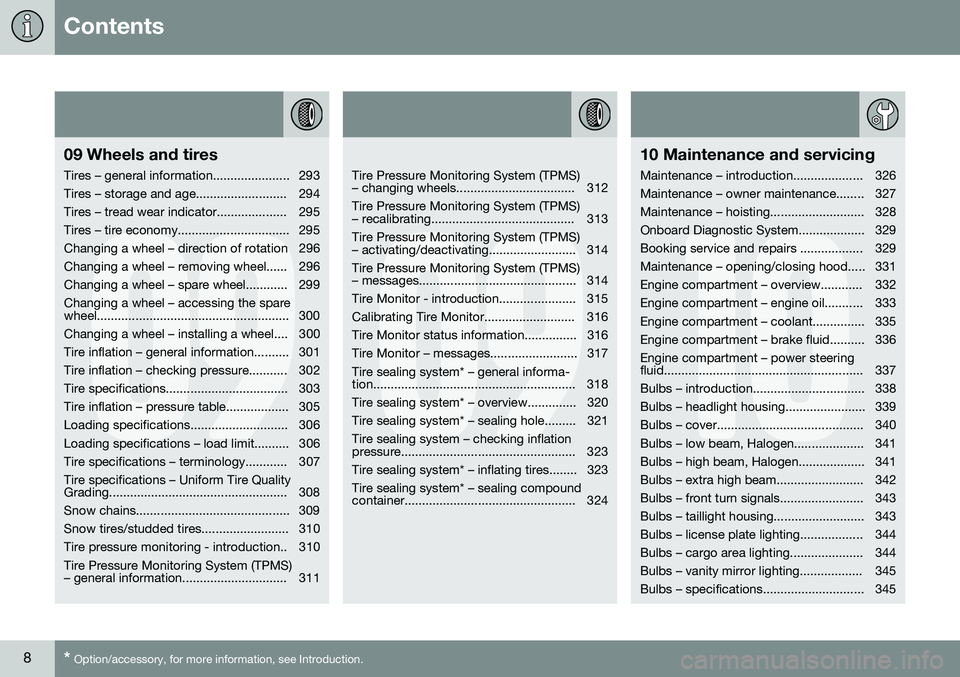
Contents
8* Option/accessory, for more information, see Introduction.
09
09 Wheels and tires
Tires – general information...................... 293
Tires – storage and age.......................... 294
Tires – tread wear indicator.................... 295
Tires – tire economy................................ 295
Changing a wheel – direction of rotation 296
Changing a wheel – removing wheel...... 296
Changing a wheel – spare wheel............ 299Changing a wheel – accessing the spare
wheel....................................................... 300
Changing a wheel – installing a wheel.... 300
Tire inflation – general information.......... 301
Tire inflation – checking pressure........... 302
Tire specifications................................... 303
Tire inflation – pressure table.................. 305
Loading specifications............................ 306
Loading specifications – load limit.......... 306
Tire specifications – terminology............ 307Tire specifications – Uniform Tire Quality
Grading................................................... 308
Snow chains............................................ 309
Snow tires/studded tires......................... 310
Tire pressure monitoring - introduction.. 310Tire Pressure Monitoring System (TPMS)
– general information.............................. 311
09
Tire Pressure Monitoring System (TPMS)
– changing wheels.................................. 312 Tire Pressure Monitoring System (TPMS)
– recalibrating......................................... 313 Tire Pressure Monitoring System (TPMS)
– activating/deactivating......................... 314 Tire Pressure Monitoring System (TPMS)
– messages............................................. 314
Tire Monitor - introduction...................... 315
Calibrating Tire Monitor.......................... 316
Tire Monitor status information............... 316
Tire Monitor – messages......................... 317Tire sealing system* – general informa-
tion.......................................................... 318
Tire sealing system* – overview.............. 320
Tire sealing system* – sealing hole......... 321Tire sealing system – checking inflation
pressure.................................................. 323
Tire sealing system* – inflating tires........ 323Tire sealing system* – sealing compound
container................................................. 324
10
10 Maintenance and servicing
Maintenance – introduction.................... 326
Maintenance – owner maintenance........ 327
Maintenance – hoisting........................... 328
Onboard Diagnostic System................... 329
Booking service and repairs .................. 329
Maintenance – opening/closing hood..... 331
Engine compartment – overview............ 332
Engine compartment – engine oil........... 333
Engine compartment – coolant............... 335
Engine compartment – brake fluid.......... 336Engine compartment – power steering
fluid......................................................... 337
Bulbs – introduction................................ 338
Bulbs – headlight housing....................... 339
Bulbs – cover.......................................... 340
Bulbs – low beam, Halogen.................... 341
Bulbs – high beam, Halogen................... 341
Bulbs – extra high beam......................... 342
Bulbs – front turn signals........................ 343
Bulbs – taillight housing.......................... 343
Bulbs – license plate lighting.................. 344
Bulbs – cargo area lighting..................... 344
Bulbs – vanity mirror lighting.................. 345
Bulbs – specifications............................. 345
Page 67 of 402
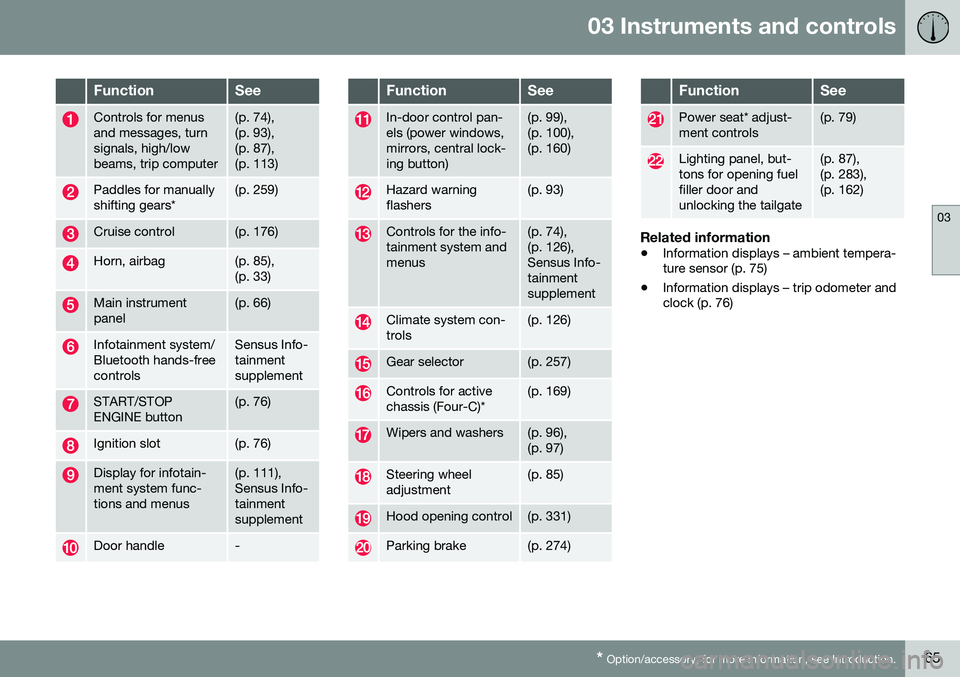
03 Instruments and controls
03
* Option/accessory, for more information, see Introduction.65
FunctionSee
Controls for menus and messages, turnsignals, high/lowbeams, trip computer(p. 74), (p. 93),(p. 87),(p. 113)
Paddles for manually shifting gears*(p. 259)
Cruise control(p. 176)
Horn, airbag(p. 85), (p. 33)
Main instrument panel(p. 66)
Infotainment system/ Bluetooth hands-freecontrolsSensus Info- tainmentsupplement
START/STOP ENGINE button(p. 76)
Ignition slot(p. 76)
Display for infotain- ment system func-tions and menus(p. 111), Sensus Info-tainmentsupplement
Door handle-
FunctionSee
In-door control pan- els (power windows,mirrors, central lock-ing button)(p. 99), (p. 100),(p. 160)
Hazard warning flashers(p. 93)
Controls for the info- tainment system andmenus(p. 74), (p. 126),Sensus Info-tainmentsupplement
Climate system con- trols(p. 126)
Gear selector(p. 257)
Controls for active chassis (Four-C)*(p. 169)
Wipers and washers(p. 96), (p. 97)
Steering wheel adjustment(p. 85)
Hood opening control(p. 331)
Parking brake(p. 274)
FunctionSee
Power seat* adjust- ment controls(p. 79)
Lighting panel, but- tons for opening fuelfiller door andunlocking the tailgate(p. 87), (p. 283),(p. 162)
Related information
• Information displays – ambient tempera- ture sensor (p. 75)
• Information displays – trip odometer andclock (p. 76)
Page 166 of 402
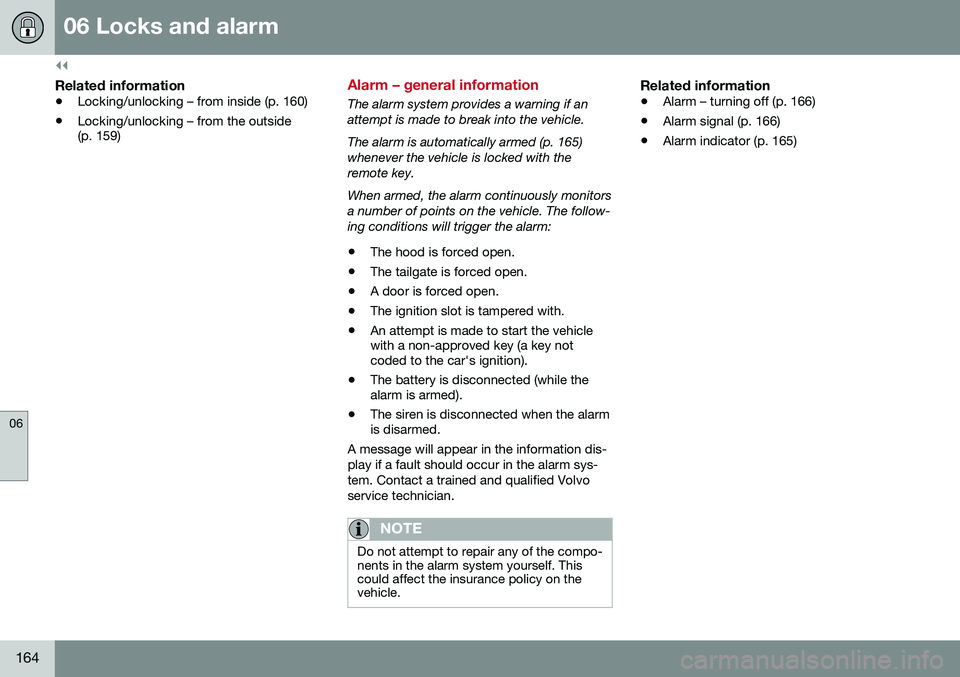
||
06 Locks and alarm
06
164
Related information
•Locking/unlocking – from inside (p. 160)
• Locking/unlocking – from the outside (p. 159)
Alarm – general information
The alarm system provides a warning if an attempt is made to break into the vehicle. The alarm is automatically armed (p. 165) whenever the vehicle is locked with theremote key. When armed, the alarm continuously monitors a number of points on the vehicle. The follow-ing conditions will trigger the alarm:
• The hood is forced open.
• The tailgate is forced open.
• A door is forced open.
• The ignition slot is tampered with.
• An attempt is made to start the vehicle with a non-approved key (a key notcoded to the car's ignition).
• The battery is disconnected (while thealarm is armed).
• The siren is disconnected when the alarmis disarmed.
A message will appear in the information dis- play if a fault should occur in the alarm sys-tem. Contact a trained and qualified Volvoservice technician.
NOTE
Do not attempt to repair any of the compo- nents in the alarm system yourself. Thiscould affect the insurance policy on thevehicle.
Related information
• Alarm – turning off (p. 166)
• Alarm signal (p. 166)
• Alarm indicator (p. 165)
Page 266 of 402

||
08 Starting and driving
08
264* Option/accessory, for more information, see Introduction.
Condition/situation
The driver is turning the steering wheel hard.
The road's incline is very steep.
A trailer's electrical system is connected to the vehicle.
The hood has been opened A
.
The transmission has not reached its nor- mal operating temperature.
Atmospheric pressure is below a level equivalent to an altitude of approx. 4,900–8,200 ft (1500–2500 m) above sea level.The actual pressure is also affected by cur-rent weather conditions.
The Adaptive Cruise Control's* Queue Assist feature is activated.
The gear selector is in the SB
or " +/–" posi-
tion.
A Certain engines only
B Sport mode (where applicable)
Related information
• Start/Stop – introduction (p. 262)
• Start/Stop – function (p. 262)
• Start/Stop – settings (p. 265)
• Start/Stop – Auto-start exceptions (p. 264) •
Start/Stop – Hill Start Assist (HSA)(p. 262)
• Start/Stop – symbols and messages(p. 266)
Start/Stop – Auto-start exceptions
In certain situations or conditions, the engine may auto-start
even though the driver is still
pressing the brake pedal, such as if:
Condition/situation
Condensation forms on the windows.
The climate system cannot keep the desired settings in the passenger compart-ment.
Electrical current consumption is tempo- rarily high or the main battery's charge isbelow the minimum level.
The brake pedal is pumped repeatedly.
The hood has been opened A
.
The vehicle begins to move or increases speed slightly (if the engine auto-stoppedbefore the vehicle was at a standstill (seeECO* (p. 267))).
The driver unbuckles his/her seat belt while the gear selector is in the D or N positions.
The steering wheel is turned A
.
Page 267 of 402
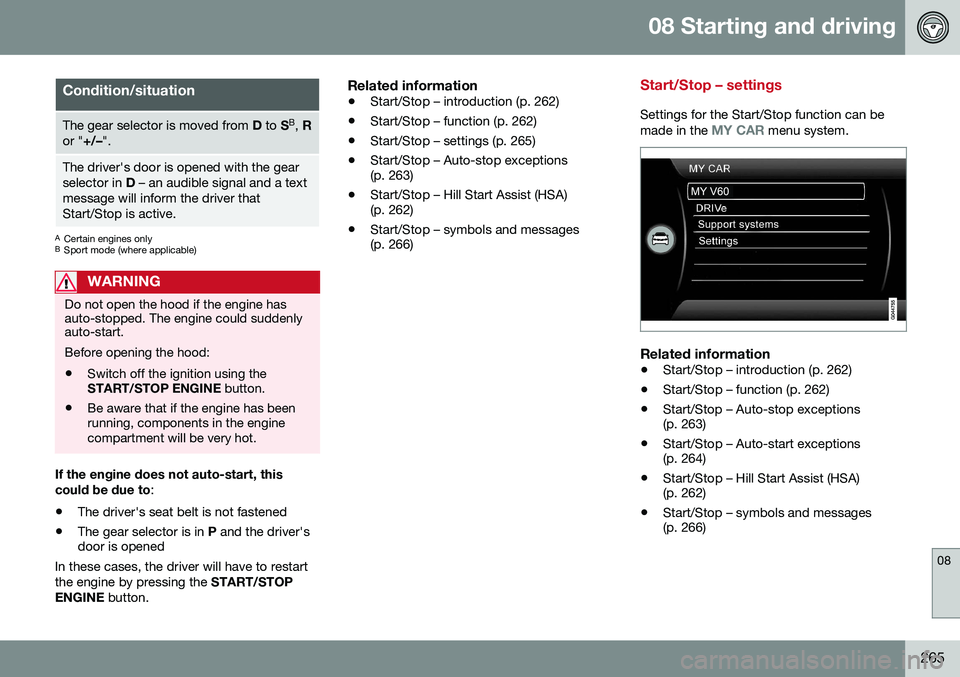
08 Starting and driving
08
265
Condition/situation
The gear selector is moved from D to SB
, R
or " +/–".
The driver's door is opened with the gear selector in D – an audible signal and a text
message will inform the driver thatStart/Stop is active.
A Certain engines only
B Sport mode (where applicable)
WARNING
Do not open the hood if the engine has auto-stopped. The engine could suddenlyauto-start. Before opening the hood:
• Switch off the ignition using the START/STOP ENGINE
button.
• Be aware that if the engine has beenrunning, components in the enginecompartment will be very hot.
If the engine does not auto-start, this could be due to
:
• The driver's seat belt is not fastened
• The gear selector is in
P and the driver's
door is opened
In these cases, the driver will have to restart the engine by pressing the START/STOP
ENGINE button.
Related information
•Start/Stop – introduction (p. 262)
• Start/Stop – function (p. 262)
• Start/Stop – settings (p. 265)
• Start/Stop – Auto-stop exceptions (p. 263)
• Start/Stop – Hill Start Assist (HSA)(p. 262)
• Start/Stop – symbols and messages(p. 266)
Start/Stop – settings
Settings for the Start/Stop function can be
made in the MY CAR menu system.
Related information
• Start/Stop – introduction (p. 262)
• Start/Stop – function (p. 262)
• Start/Stop – Auto-stop exceptions (p. 263)
• Start/Stop – Auto-start exceptions(p. 264)
• Start/Stop – Hill Start Assist (HSA)(p. 262)
• Start/Stop – symbols and messages(p. 266)
Page 329 of 402
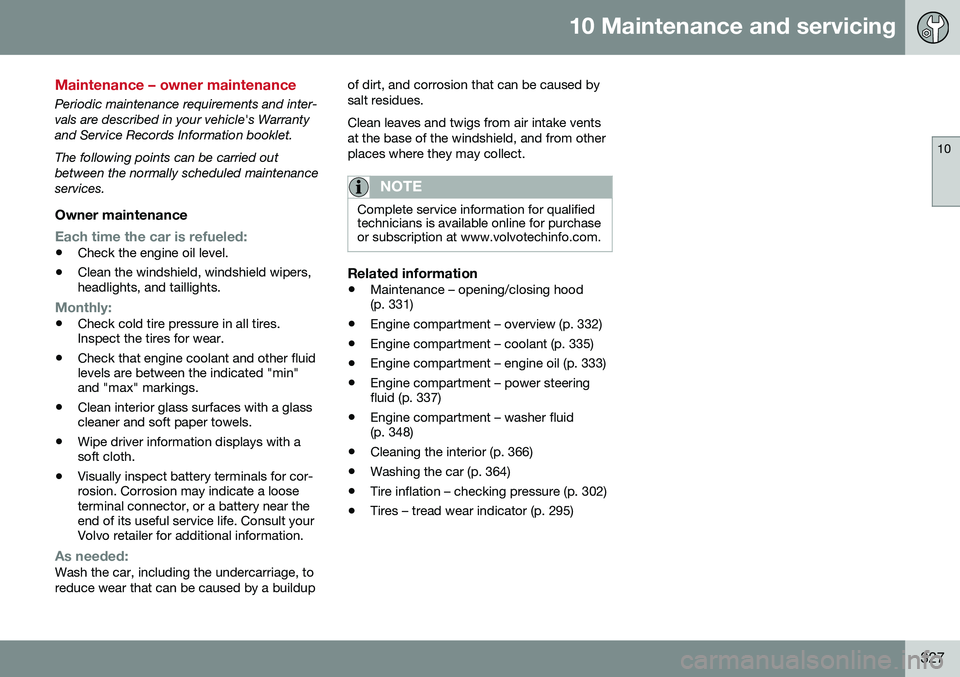
10 Maintenance and servicing
10
327
Maintenance – owner maintenance
Periodic maintenance requirements and inter- vals are described in your vehicle's Warrantyand Service Records Information booklet. The following points can be carried out between the normally scheduled maintenanceservices.
Owner maintenance
Each time the car is refueled:
•Check the engine oil level.
• Clean the windshield, windshield wipers, headlights, and taillights.
Monthly:
• Check cold tire pressure in all tires. Inspect the tires for wear.
• Check that engine coolant and other fluidlevels are between the indicated "min"and "max" markings.
• Clean interior glass surfaces with a glasscleaner and soft paper towels.
• Wipe driver information displays with asoft cloth.
• Visually inspect battery terminals for cor-rosion. Corrosion may indicate a looseterminal connector, or a battery near theend of its useful service life. Consult yourVolvo retailer for additional information.
As needed:Wash the car, including the undercarriage, to reduce wear that can be caused by a buildup of dirt, and corrosion that can be caused bysalt residues. Clean leaves and twigs from air intake vents at the base of the windshield, and from otherplaces where they may collect.
NOTE
Complete service information for qualified technicians is available online for purchaseor subscription at www.volvotechinfo.com.
Related information
•
Maintenance – opening/closing hood (p. 331)
• Engine compartment – overview (p. 332)
• Engine compartment – coolant (p. 335)
• Engine compartment – engine oil (p. 333)
• Engine compartment – power steeringfluid (p. 337)
• Engine compartment – washer fluid(p. 348)
• Cleaning the interior (p. 366)
• Washing the car (p. 364)
• Tire inflation – checking pressure (p. 302)
• Tires – tread wear indicator (p. 295)
Page 333 of 402
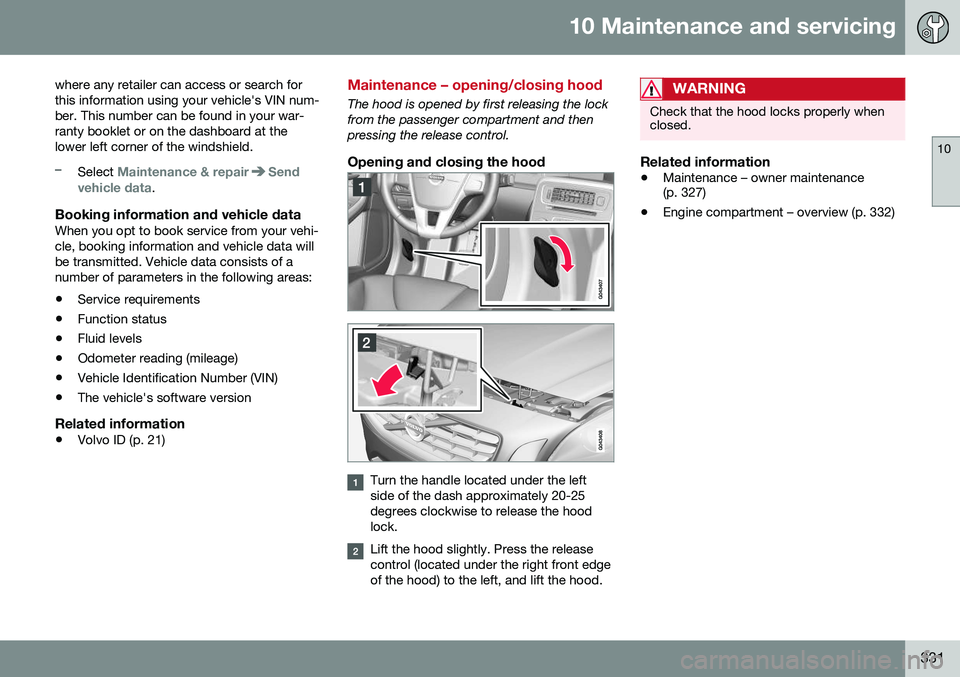
10 Maintenance and servicing
10
331
where any retailer can access or search for this information using your vehicle's VIN num-ber. This number can be found in your war-ranty booklet or on the dashboard at thelower left corner of the windshield.
–Select Maintenance & repairSend
vehicle data.
Booking information and vehicle dataWhen you opt to book service from your vehi- cle, booking information and vehicle data willbe transmitted. Vehicle data consists of anumber of parameters in the following areas:
• Service requirements
• Function status
• Fluid levels
• Odometer reading (mileage)
• Vehicle Identification Number (VIN)
• The vehicle's software version
Related information
•Volvo ID (p. 21)
Maintenance – opening/closing hood
The hood is opened by first releasing the lock from the passenger compartment and thenpressing the release control.
Opening and closing the hood
Turn the handle located under the left side of the dash approximately 20-25degrees clockwise to release the hoodlock.
Lift the hood slightly. Press the release control (located under the right front edgeof the hood) to the left, and lift the hood.
WARNING
Check that the hood locks properly when closed.
Related information
•Maintenance – owner maintenance (p. 327)
• Engine compartment – overview (p. 332)
Page 335 of 402

10 Maintenance and servicing
10
}}
333
Related information
•Maintenance – opening/closing hood (p. 331)
• Maintenance – owner maintenance(p. 327)
Engine compartment – engine oil
The correct oil must be used for the stated oil change (service) intervals to apply. The oil level on 4-cylinder engines is checked electronically and is checked using a dipstickon 5- and 6-cylinder engines.
Checking the engine oil (5- and 6-
cylinder engines)
The oil level should be checked at regularintervals, particularly during the period up tothe first scheduled maintenance service.
• See Oil specifications (p. 381) for oil specifications.
• Also, refer to the Warranty and ServiceRecords information booklet for informa-tion on oil change intervals and oil speci-fications.
CAUTION
•Not checking the oil level regularly can result in serious engine damage if theoil level becomes too low.
• Oil that is lower than the specifiedquality can damage the engine.
• Volvo does not recommend the use ofoil additives.
• Always add oil of the same type andviscosity as already used.
• Never fill oil above the
MAX mark. This
could cause an increase in oil con-sumption.
• Oil changes should be carried out by atrained and qualified Volvo servicetechnician.
Page 375 of 402

11 Specifications
11
373
List of labelsVehicle Emission Control Information. Your Volvo is designed to meet all appli- cable emission standards, as evidencedby the certification label on the undersideof the hood. For further information regar-ding these regulations, please consultyour Volvo retailer.
Engine oil. This label contains the recom-
mended engine oil specifications.
Vehicle Identification Number (VIN). The VIN plate is located on the top left surface of the dashboard. The VehicleIdentification Number (VIN) should alwaysbe quoted in all correspondence concern-ing your vehicle with the retailer and whenordering parts.
Tire inflation pressures. This label indi-
cates the correct inflation pressures for the tires that were on the vehicle when itleft the factory.
Federal Motor Vehicle Safety Stand- ards (FMVSS) specifications (USA) andMinistry of Transport (CMVSS) stand- ards (Canada). Your Volvo is designed to
meet all applicable safety standards, as evidenced by the certification label on thedriver's side B-pillar (the structural mem-ber at the side of the vehicle, at the rearof the driver's door opening). This labelalso includes codes for paint color, etc.For further information regarding theseregulations, please consult your Volvoretailer. U.S. models have the upperdecal; Canadian models have the lowerone.
Related information
• Weights (p. 378)
• Engine specifications (p. 380)
Page 395 of 402

12 Index
12
393
High beams................................................ 88
active.................................................... 88
Hill Descent Control......................... 269, 270
Hill Start Assist (HSA).............................. 257
Hoisting the vehicle................................. 328 HomeLink ®
Wireless Control
System............................................. 106, 107
Home safe lighting..................................... 95
Hood, opening/closing............................ 331
Horn........................................................... 86
I
ID, Volvo.................................................... 21
Ignition modes..................................... 76, 77
Immobilizer.............................................. 148
Important information.......................... 13, 14
Indicator lights............................... 66, 68, 72
Infant seats................................................ 49
Inflatable Curtain........................................ 41
Inflation pressure............................. 301, 302
Inflation pressure table............................ 305Information and warning symbols, table
of.............................................................. 386
Information lights........................... 66, 68, 72 Inspection readiness................................ 329
Instrument lighting..................................... 91
"theater" lighting................................... 91
Instrument overview............................ 63, 66
Instrument panel........................ 66, 111, 112Integrated two-stage booster
cushion.......................................... 57, 59, 60
Interior Air Quality System....................... 123
Interior lighting........................................... 94Internet connection booking service.................................. 329
ISOFIX/LATCH anchors............................. 55J
Jack attaching............................................. 296
location of........................................... 296
Jump starting........................................... 256
K
Key blade. 146, 147, 150, 151, 152, 153, 156 private locking.................................... 152
Keyless drive............................................ 155 general description............. 156, 157, 158
starting the vehicle............................. 252
Keyless locking/unlocking....................... 155
L
Labels list of................................................... 373
location of........................................... 372
Lane Departure Warning (LDW) 222, 223, 224, 225
Lane Keeping Aid............ 227, 228, 230, 231
LATCH anchors......................................... 55
Leather care............................................. 366
Lighting panel............................................ 87
Loading the vehicle.................. 139, 140, 306 roof loads............................................ 139
Locking.................................... 159, 160, 162 tailgate................................................ 162
Locking the vehicle.................................. 149
Locks, child safety..................................... 61